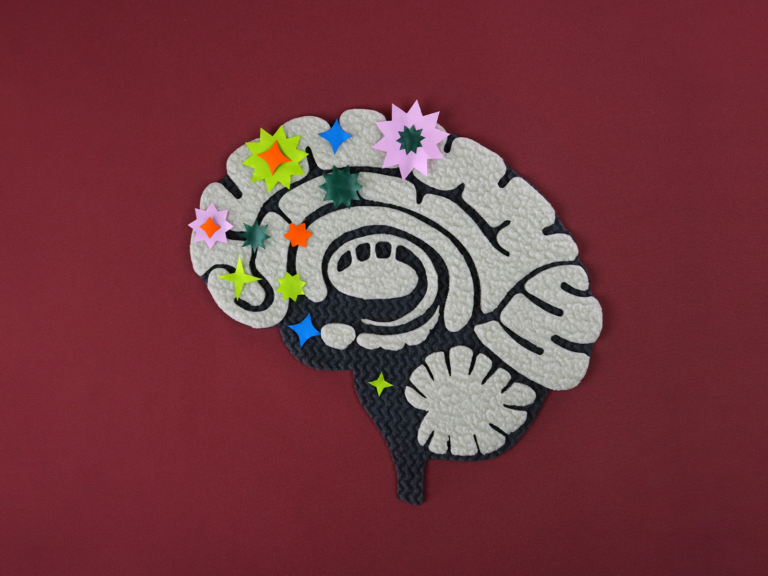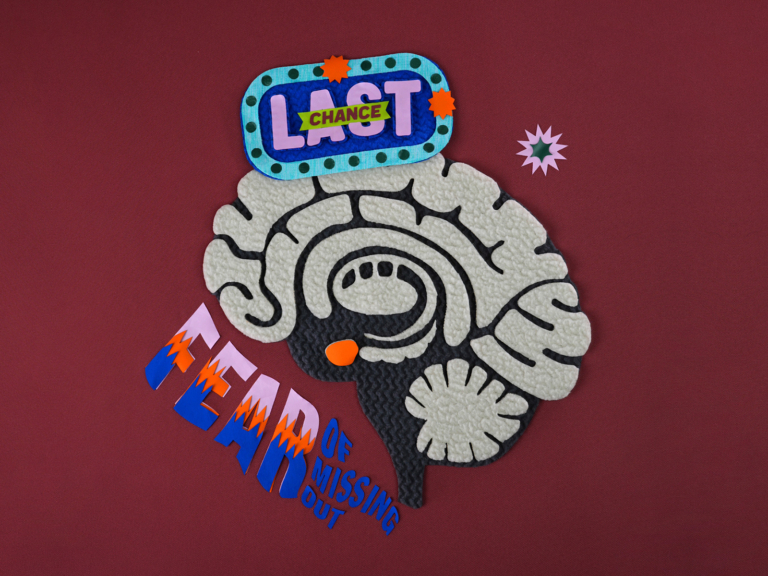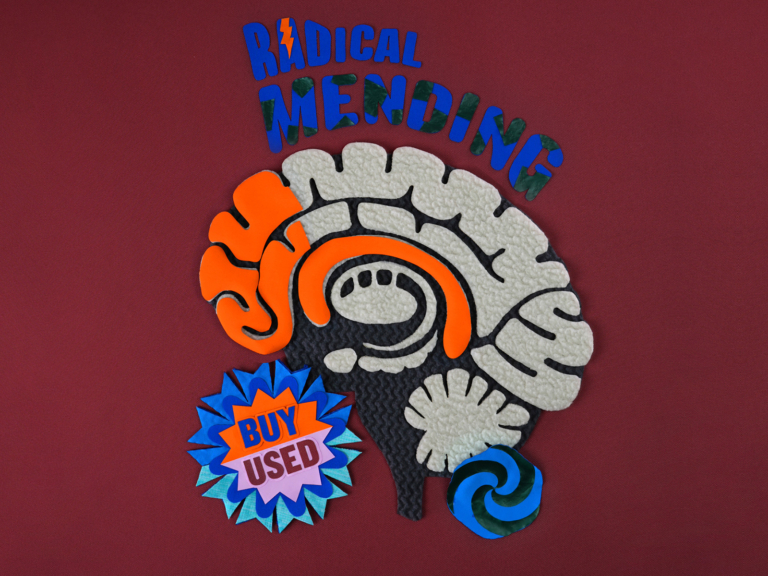Why Do We Keep Buying New Stuff?
All illustrations by Naíma Almeida
Buying our first home was a lesson in thoughtful consumption. Our previous rentals were filled with unmemorable pieces that had little life after our leases ended. Now that my husband and I were privileged to have our own space, we wanted to fill it with things that could grow old with us. That didn’t mean we could buy whatever we wanted—a down payment and decades of mortgage payments to come are a sobering guardrail—but this time, we wanted what we brought into the house to count.
We succeeded for the most part—a 1940s-era dining table from the swap meet, hand-me-down rugs from family and new pieces with craftsmanship to back it up—but our sofa was a dud. It was too small for the space and too small for two humans plus one large dog to all comfortably stretch out. When we finally decided to save up for a replacement, we did our research, sat on dozens of options and mimicked our movie-night supine positions right there in stores. We wanted this one to be around for the long haul. So the most pressing question we asked the salesperson was how long it would last.
“You’ll probably get tired of it before it stops holding up,” she responded.
I didn’t want to admit to myself that she might be right. Truthfully, I was ignoring the fact that another reason I wanted a new sofa was that I had gotten bored with our current one. I had tried to mask it with more practical reasons, but yes, a part of me wanted something shiny and new.
As it turns out, my want wasn’t just emotional. It was also neurological. Whether it’s furniture, clothing, food or a refreshed social media timeline, our brains pay attention to novelty. The new-to-us provides a real, albeit small, neurological boost: a little pulse of dopamine, the feel-good neurotransmitter that generates a positive response, every time we attend to something new.
“From a survival point of view, you can imagine why that would be,” says Dr. Ann-Christine Duhaime, professor of neurosurgery at Harvard Medical School, Director of Pediatric Neurosurgery at the Massachusetts General Hospital, and author of Minding the Climate: How Neuroscience Can Help Solve Our Environmental Crisis. “If you’re a prehistoric human or animal and you find a new blueberry patch, it’s really good. If you find a new threat like a predator and you don’t pay attention, that’s bad. The way your nervous system is designed, novelty grabs your attention more than something that is familiar.”

We crave new things because, in part, our brains nudge us in that direction. It worked for prehistoric hunter-gather communities—new berry patch: good; saber-tooth tiger: bad—but today, it’s a trait that’s contributing to overconsumption and the climate crisis.
These signals are part of the brain’s reward system, a feedback loop that helps us make decisions. According to Duhaime in this simplified explainer, first, we get dopamine like a tiny gold star for noticing novelty (called an “alerting response”), which helps reinforce the behavior. This is quickly followed by other reactions depending on what the novel thing is. Then, we make a choice. Finally, we experience the outcome. And if it’s a rewarding experience, our brains work with the memory center (the hippocampus) to reinforce that positive association.
As that reward system evolved, our preference wasn’t just for novelty but a lot of novelty. Evolutionarily, we didn’t need to develop strong brake pedals because scarcity was the norm. But after the Industrial Revolutions of the late 1700s and post-World War II years brought scale, speed and abundance, “everything in moderation” has become a quaint suggestion rather than a survival mechanism.
Now we need those brake pedals more than ever. Consumption has exploded. Between 2000 and 2015, production of clothing, footwear and accessories doubled globally, according to the Ellen MacArthur Foundation. Or consider it on an individual level. In 1930, the average American woman owned nine outfits. Today, it’s nearly tripled, says professor and author Sandra Goldmark in her book Fixation. For people with more disposable income, that number might be even higher.
Making stuff—clothes or otherwise—doesn’t come free to the planet, but that cause-effect equation seems less tangible, or publicized, than the environmental cost of food. We understand that it takes land, water, manual labor and other resources to make food. Our clothes start the same way—whether it’s cotton, hemp or petroleum to make virgin synthetic materials. But it’s easy to ignore that clothes start as crops and use vast resources and require huge numbers of workers, from fabric to finish. The disconnect is real.
Some estimates say the clothing industry accounts for up to 10 percent of global carbon emissions, with the lion’s share during production and processing—from the raw materials that are drilled, mined, clear-cut and extracted to the water and energy (often coal) to power the machines that make clothing. Even the most noble efforts, like recycled materials or organic cotton, can’t fully erase the impact. An example straight from the horse’s mouth: At Patagonia in 2023, about 90 percent of our emissions have come from our supply chain and material manufacturing.
Once people are done with their clothes, unless they’re handed down, recycled or upcycled, most are landfilled or incinerated. In 2018, that was 85 percent of clothing, according to the Environmental Protection Agency—that’s nearly 88 pounds of waste per person. We don’t absorb the magnitude of that waste because once we’re done, those garments are someone else’s problem: trash haulers, nonprofits sorting through mountains of often unusable donations, or other countries where these clothes pile up. This insidious take-make-waste system could bloat the industry’s emission footprint to 50 percent by 2030.
Of course, there’s another reward system at play. One that incentivizes CEOs, shareholders and others to sell us stuff and even make buying new an easier and cheaper option than repairing what we already have. While researching her book, neurologist Dr. Ann-Christine Duhaime came across journals for marketing professionals that analyzed that neurology.
“This research was done with selling in mind,” she says. “We have this idea that the economy must continue to grow, but think about who wants you to buy this and why. They’re not going to say, ‘I want you to buy this so that my CEO and my VP get bonuses.’ They’re going to say you should buy this because it will make you look better. That consumption adds to this really serious existential crisis we’re in, and it adds up all over the world.”
Before you condemn yourself for that all-consuming mindset, remember that your brain is guiding some of that subconscious, behind-the-scenes work. Shopping, in particular, gives our brains an immediate, short-range reward. It’s instant gratification. But after a few years or months (or weeks), what you got then feels less exciting now. Like my sofa or when I look at my full closet and say that I have “nothing” to wear.
One culprit is fast fashion, which specializes in a revolving door of trends, making us feel like we need more, more often. And because these clothes are cheap and wear out sooner, the urge to replace them seems reasonable and accessible. The other culprit of a “more is more” mentality is our neurology. Our brains shrink reward value over time to make space to learn new stuff. If we want to achieve the same “high” we got after our most recent buy, we often have to buy, buy again. According to the consulting firm McKinsey, people wear clothes 36 percent fewer times than they did 15 years ago on average.
“Evolutionarily, if you always exploited the same opportunity, you’d never explore new ones,” says Dr. Uma R. Karmarkar, an assistant professor of consumer psychology at UC San Diego’s School of Global Policy and Strategy. “Novelty is really useful in finding food and sourcing new information and exploring the world around us. It makes sure we don’t get stuck and gives us the opportunity to do even better.”
Karmarkar is explaining the psychology to me for background, but even so, the thought of new-to-us clothing as an opportunity to do better feels laughable at its best and indulgent, self-serving and shameful at its worst. And judging by the number of Marie Kondo acolytes who have sprouted up in the past decade-plus years, there are plenty of people who understand the “less is more” mantra. Yet we still consume. That’s because, Karmarkar says, when we decide to buy something, it isn’t just neurological signals that come into play, but also a complex interplay of our emotions, wants, needs and external pressures.
“There’s a huge volume of factors nudging you—or really shoving you—in the direction of buying,” Karmarkar says. “You could get a deal, and that adds to the reward. Another is scarcity—if you don’t get it, you’ll never be able to get it again. Or there’s social pressure. The fear of missing out is a real psychological thing. If it’s a high intensity moment like Black Friday, the social information you’re getting is ‘I’m just doing what the crowd’s doing.’ If you leave a store empty-handed, did you make a mistake? We often buy things we don’t even like because the decision process itself is fun.”

Discounts, exclusivity and scarcity can all impact the reward we assign to something we’re about to buy—and whether we go through with the purchase.
Understanding those biological and emotional ticks can help explain why stunts like Summer Black Friday or Amazon Prime Day exist. Those with a bottom line understand exactly how to engage us, even in how they collect payment. And when we joke that “buying this hurts my wallet,” it isn’t just a metaphor. The “pain of paying”—a phrase coined by behavioral scientist Ofer Zellermayer in 1996—is real.
“Brain studies have shown that it’s not physical pain we’re feeling—those circuits don’t overlap—but it is emotional pain,” Karmarkar says. “It’s more like the brain’s response to unpleasantness or feeling sad than it is to an electric shock.”
Physical cash carries the biggest gut punch, she says. Digital shopping, on the other hand, has the lowest pain of paying, whether it’s online shopping, Venmo, Apple Pay or, perhaps in the not-too-distant future, blinking twice. Without a physical wallet and no handing over of bills or a credit card, we’ve nearly obliterated pain that could be a useful guardrail to keep us from overspending and overconsuming.
Instead, we’ve funneled even more emotions into the garments themselves. Clothes aren’t just a matter of utility anymore. They’re a form of self-expression—of who we are, who we want to be and what we value, whether it’s designer labels, vintage aesthetics, athleisure, recycled, upcycled, handmade, organic, made in the US, made in Fair Trade Certified™ factory, you name it. Even as kids we understand the power of what we wear. When I was in elementary school, I so badly wanted a store-bought Cleopatra costume for Halloween and felt decidedly uncool for rolling up to school as a homemade, hand-stitched Egyptian queen.
My parents, too, despite their kibosh on my costume, understood the cultural cache and social currency of “new.” Years ago, I mistakenly thought they bought our family car from the used lot, and they swiftly corrected me that “It’s new and don’t ever tell anyone it’s used.” Buying something new—not secondhand, not handed down from a relative—was a sign that these two immigrants had made it in America.
When it’s more biological than cultural, Duhaime reminds us that it’s novelty, not necessarily new, that our brains are after. There are ways to fill our emotional cups in satisfying, less-extractive ways, like buying used, borrowing from friends and repairing clothes so they’re like-new. Novelty isn’t inherently bad, but instead of being bummed out about buying less stuff, what if we saw it as an opportunity to make those fewer opportunities count? And where else can we find novelty?
“Anything that’s rewarding is not rewarding on one dimension,” Duhaime says. “Let’s say you have something—a photograph, pottery or furniture—that’s been in your family for a long time. If you have associations with that thing, that’s a whole different dimension of reward. It has these other layers of meaning and memory, and then you add in the reward of ‘I didn’t consume more than I needed to.’”
She explains that even though humans and animals are predisposed—not hard-wired—to respond to novelty, it’s just one of many forces we react to. Other factors, like our concern for the climate crisis, can change our priorities.
“Social rewards have a very strong power,” she says. “If you feel like an outlier, it’s harder to change. But if you find like-minded people and reinforce each other through social rewards, where you get validation from the people you surround yourself with, that’s how habits spread—like-minded people having similar motivations to make the change together. Each of us has a sphere of influence.”
Duhaime shares a story about her favorite pair of alpaca gloves, worn and riddled with holes. She had never mended anything, but she went to a yarn store and began chatting about sewing options with the owner, who raised her elbow to proudly display a patch that highlighted, rather than hid, the repair job.
“We started talking about radical mending,” she says. “She got as much of a kick out of her one-of-a-kind sweater as I did. Now I love showing off my gloves. They’re really cool-looking. I didn’t have to get new gloves, and it saved me money. Your nervous system is designed to be changeable in what you find rewarding, and you can find creativity, pride and even style credibility without necessarily increasing consumption.”

“We are human beings. We need to have joy,” Dr. Ann-Christine Duhaime says. “But you can eat well and eat better things for the planet. You can do things that are really fun that are better for the planet. You can make choices that are better for you and your children and your children’s children, and it still can be a lot of fun. We need to have a vision of a better future.”
You can also send a message. Steve Jobs’ uniform of black mock turtlenecks, jeans and sneakers conveyed simplicity, consistency and a can’t-be-bothered-with-fashion attitude. Some believed that Princess Diana wore a sweater embroidered with all white sheep and just one black sheep as a nod to her own feelings about where she stood with the Royal Family. And then there’s the time Lady Gaga wore a meat dress to a 2010 red carpet to make a statement about fighting for personal rights.
Similarly, wearing used, repaired or passed-down clothing can send the message that we have enough, that doing more with what we already have isn’t just a fashion statement but also necessary for a better future.
“Hitting people over the head with ‘The planet is burning!’ can push people away,” Duhaime says. “But you can pull people into thinking about these problems with something like a cool sweater that you fixed yourself with a beautiful embroidery pattern. We can consume less and make changes in our lives without giving up the joy of life. We don’t have to be hermits, but we have an obligation to take this problem more seriously than we’ve taken it in the past.”

